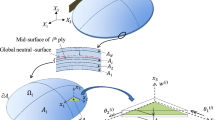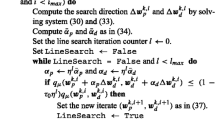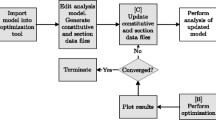Abstract
Motivated by needs such as those in the aerospace industry, this paper develops and demonstrates a method for optimizing laminated composite shell components considering the natural frequency, damping and deflection subjected to a concentrated load on the center of the plate in hygrothermal environments by manipulating individual ply angles and thicknesses. Optimization is performed by synergizing an FEA with a gradient-based modified feasible direction optimization algorithm. The objective is to minimize the weight of the plates within the given design space via the constraint of the first natural frequency, dampings of the first vibration modes and deflections caused by the applied hygro-thermo-mechanical loads. Illustrative applications involve six-ply symmetric rectangular laminated panels simply supported along four edges, although the method is applicable to more complicated laminates, geometries and boundary conditions. The panel geometry is discretized into specially-developed, 3D-degenerated eight-node shell isoparametric layered composite elements. Through a numerical example, it is shown that hygro-thermal effects play an important role in the optimal design of laminated composites.
Similar content being viewed by others
Abbreviations
- er, es, et :
-
shell element directional unit vectors
- N k :
-
shape function
- V kn :
-
normal vector to the shell mid-surface
- [C sh ]:
-
shell element material stiffness matrix
- [T sh ]:
-
shell element transformation matrix
- α xx :
-
x-direction thermal expansion coefficient
- β xx :
-
x-direction hygro coefficient
- R I :
-
thermally induced equivalent nodal force
- ɛ th :
-
thermal strain
- ɛ hy :
-
hygro strain
- Ψ :
-
damping capacity
- U e :
-
total strain energy
- [K s ]:
-
static stiffness matrix
- [K th ]:
-
temperature stiffness matrix
- [K hy ]:
-
moisture stiffness matrix
- [B]:
-
strain-displacement matrix
- [M]:
-
mass matrix
References
Lee, S. Y. and Yen, W. J., “Hygrothermal effects on the stability of a cylindrical composite shell panel,” Computers and Structures, Vol. 33, No. 2, pp. 551–559, 1989.
Haddad, Y. M. and Feng, J., “On the optimization of the mechanical behavior of a class of composite systems under both quasi-static and dynamic loading,” Journal of Materials Processing Technology, Vol. 119, No. 1–3, pp. 222–228, 2001.
Cho, H. K. and Rowlands, R. E., “Maximizing buckling strength of perforated composite laminates by optimizing fiber orientation using genetic algorithm,” Proceedings of ASME IMECE2006, 2006.
Khalil, M., Darnis, P., and Ramahefarison, E., “Optimization of laminated composites under static and dynamic constraints,” Proceedings of ASME, Petroleum Deivision, Vol. 64, pp. 147–159, 1994.
Gürdal, Z., Haftka, R. T., and Hajela, P., “Design and Optimization of Laminated Composite Materials,” Wiley, 1999.
Soremekun, G., Gürdal, Z., Haftka, R. T., and Watson, L. T., “Composite laminate design optimization by genetic algorithm with generalized elitist selection,” Computers and Structures, Vol. 79, No. 2, pp. 131–143, 2001.
Hirano, Y., “Optimum Design of Laminated Plates Under Shear,” Journal of Composite Materials, Vol. 13, No. 4, pp. 329–334, 1979.
Tauchert, T. R. and Adibhatla, S., “Design of Laminated Plates for Maximum Bending Strength,” Engineering Optimization, Vol. 8, No. 4, pp. 253–263, 1985.
Watkins, R. I. and Morris, A. J., “A multicriteria objective function optimization scheme for laminated composites for use in multilevel structural optimization schemes,” Computer Methods in Applied Mechanics and Engineering, Vol. 60, No. 2, pp. 233–251, 1987.
Kam, T. Y. and Chang, R. R., “Optimal design of laminated composite plates with dynamic and static considerations,” Computers and Structures, Vol. 32, No. 2, pp. 387–393, 1989.
Bathe, K. J., “Finite Element Procedures in Engineering Analysis,” Prentice-Hall International, 1982.
Reddy, J. N., “Mechanics of Laminated Composite Plates: Theory and Analysis,” CRC Press, 1997.
Chang, T. Y. and Sawamiphakdi, K., “Large deformation analysis of laminated shells by ftnife element method,” Computers and Structures, Vol. 13, No. 1–3, pp. 331–340, 1981.
Lin, D. X., Ni, R. G., and Adams, R. D., “Prediction and Measurement of the Vibrational Damping Parameters of Carbon and Glass Fiber-Reinforced Plastics Plates,” Journal of Composite Materials, Vol. 18, No. 2, pp. 132–152, 1984.
Bae, J. H. and Kim, C., “Optimal Design for Compressed Natural Gas Composite Vessel By Using Coupled Model with Linear and Composite Layer,” Int. J. Precis. Eng. Manuf., Vol. 14, No. 22, pp. 275–281, 2013.
Narita, Y. and Robinson, P., “Maximizing the fundamental frequency of laminated cylindrical panels using layerwise optimization,” International Journal of Mechanical Sciences, Vol. 48, No. 12, pp. 1516–1524, 2006.
Author information
Authors and Affiliations
Corresponding author
Rights and permissions
About this article
Cite this article
Cho, HK. Design optimization of laminated composite plates with static and dynamic considerations in hygrothermal environments. Int. J. Precis. Eng. Manuf. 14, 1387–1394 (2013). https://doi.org/10.1007/s12541-013-0187-7
Received:
Accepted:
Published:
Issue Date:
DOI: https://doi.org/10.1007/s12541-013-0187-7




